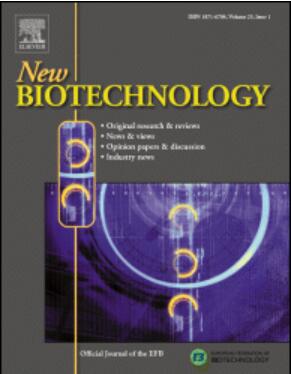Effect of operating conditions on the microbial selection of P(3HB-co-3HV) producers in open continuous culture
IF 4.9
2区 生物学
Q1 BIOCHEMICAL RESEARCH METHODS
引用次数: 0
Abstract
From the perspective of producing P(3HB-co-3HV), the selection of PHA accumulating organisms from activated sludge with a feeding incorporating propionate was investigated in open continuous culture under dual carbon and phosphorus limitation conditions. The selected consortia were then harvested in batch cultures with phosphorus (P) deficiency to evaluate their PHA storage potential. Microbial selection exhibited consistent functional stability of PHA production, emphasizing the robustness of this enrichment strategy. A comparison with previous studies revealed that at a given degree of P limitation, the distribution of carbon consumption between cell growth, PHA storage and maintenance reactions was conditioned by the nature of the carbon source. The combination of the nature of the carbon substrate, the degree of P limitation and the dilution rate governs microbial competition. The dominant bacterial genera showed very heterogeneous PHA production capacities. Acinetobacter spp., whose establishment was favored by the presence of acetate, a high dilution rate, and a low C/P ratio, was found to be a poor producer. In contrast, Malikia spp. and Zoogloea spp., mostly selected with butyrate, a lower dilution rate, and strong P limitation, exhibited high specific PHA production rates.
开放式连续培养中操作条件对P(3HB-co-3HV)生产者微生物选择的影响
从产P(3HB-co-3HV)的角度出发,在双限碳、限磷条件下,在开放式连续培养条件下,研究了丙酸饲料对活性污泥中PHA积累菌的筛选。然后在磷(P)缺乏的批次培养中收获选定的菌落,以评估其PHA储存潜力。微生物选择显示出PHA生产的一致性功能稳定性,强调了这种富集策略的稳健性。通过与前人研究的比较发现,在一定程度的磷限制下,细胞生长、PHA储存和维持反应之间的碳消耗分布受碳源性质的制约。碳基质的性质、磷限制程度和稀释率共同决定了微生物的竞争。优势菌属的PHA生产能力差异很大。不动杆菌(Acinetobacter spp)是一个较差的生产者,它的建立有利于乙酸的存在,稀释率高,C/P比低。相比之下,Malikia spp.和Zoogloea spp.,主要选择丁酸盐,稀释率较低,P限制强,具有较高的PHA特异性生产速率。
本文章由计算机程序翻译,如有差异,请以英文原文为准。
求助全文
约1分钟内获得全文
求助全文
来源期刊

New biotechnology
生物-生化研究方法
CiteScore
11.40
自引率
1.90%
发文量
77
审稿时长
1 months
期刊介绍:
New Biotechnology is the official journal of the European Federation of Biotechnology (EFB) and is published bimonthly. It covers both the science of biotechnology and its surrounding political, business and financial milieu. The journal publishes peer-reviewed basic research papers, authoritative reviews, feature articles and opinions in all areas of biotechnology. It reflects the full diversity of current biotechnology science, particularly those advances in research and practice that open opportunities for exploitation of knowledge, commercially or otherwise, together with news, discussion and comment on broader issues of general interest and concern. The outlook is fully international.
The scope of the journal includes the research, industrial and commercial aspects of biotechnology, in areas such as: Healthcare and Pharmaceuticals; Food and Agriculture; Biofuels; Genetic Engineering and Molecular Biology; Genomics and Synthetic Biology; Nanotechnology; Environment and Biodiversity; Biocatalysis; Bioremediation; Process engineering.
 求助内容:
求助内容: 应助结果提醒方式:
应助结果提醒方式:


